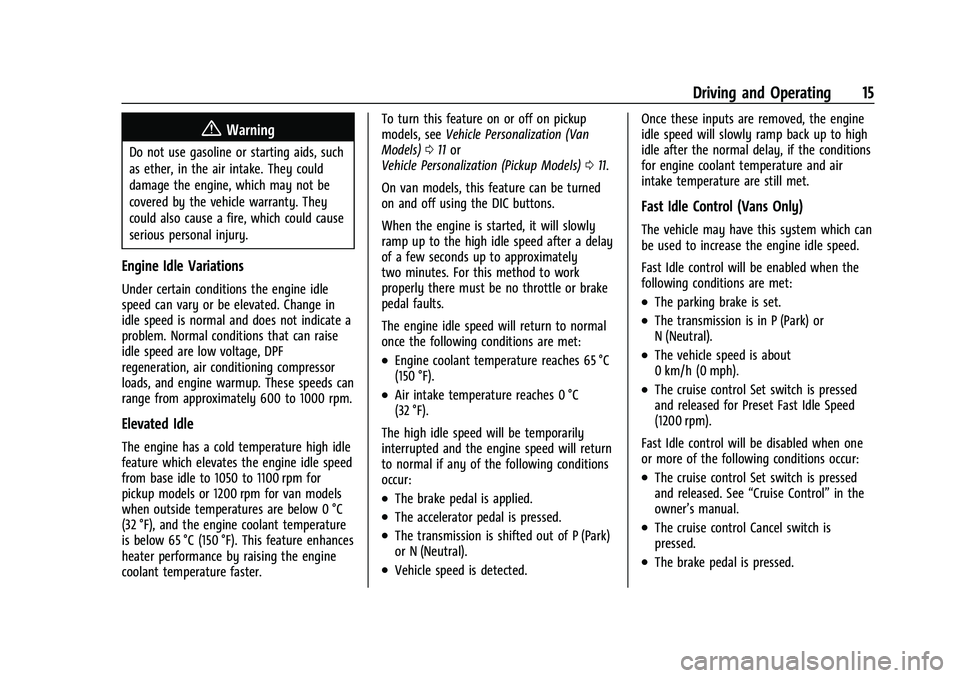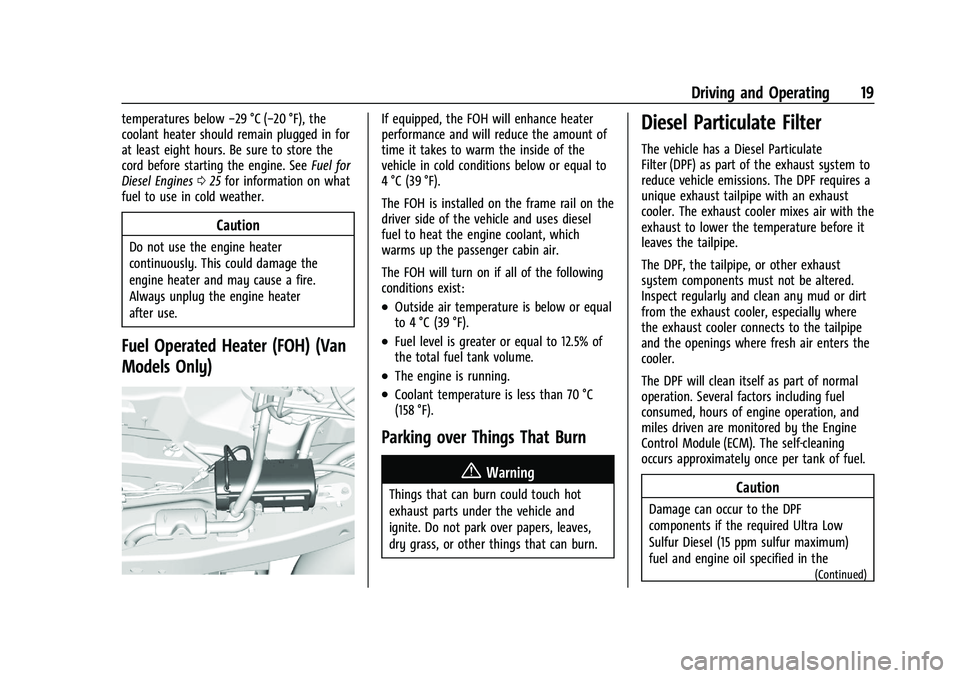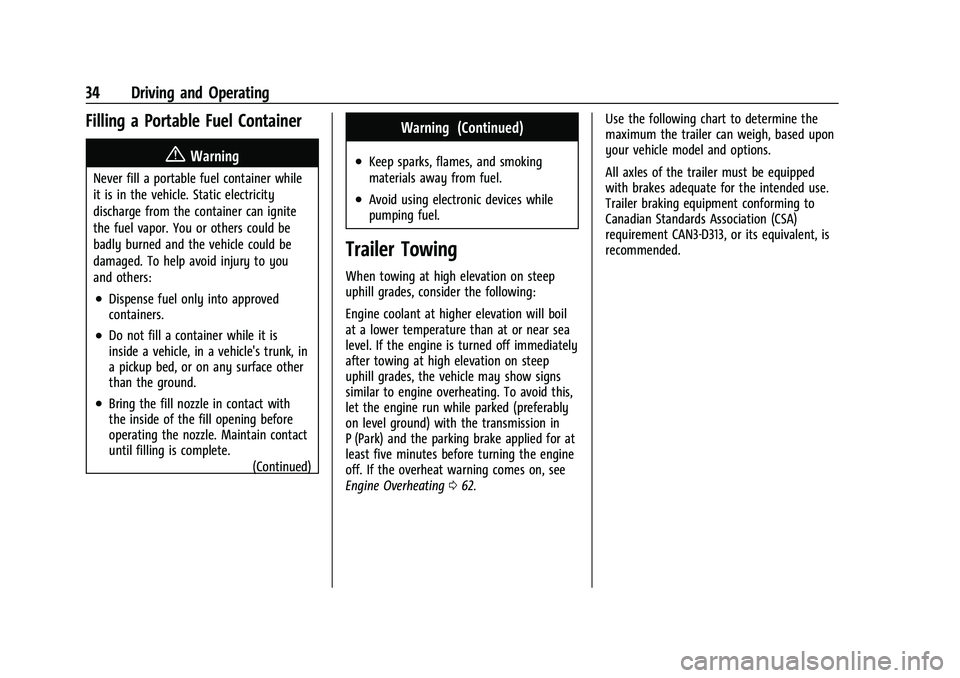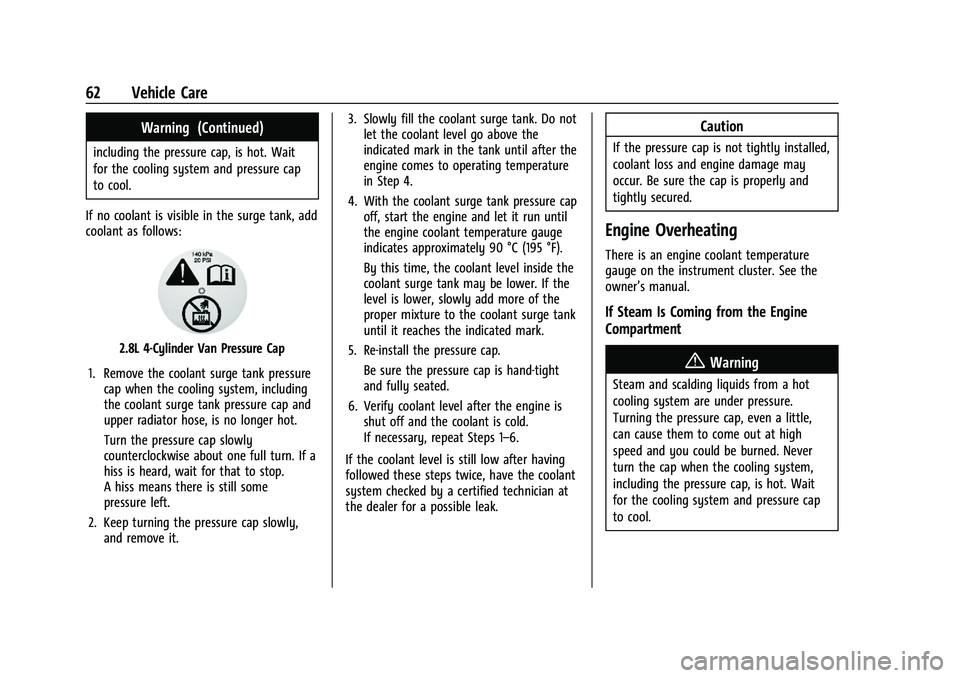2021 CHEVROLET COLORADO coolant temperature
[x] Cancel search: coolant temperaturePage 15 of 89

Chevrolet/GMC 2.8L Duramax Diesel Engine Supplement (GMNA-Localizing-
U.S./Canada-14465442) - 2021 - CRC - 2/3/20
14 Driving and Operating
Observe the wait-to-start light. See
Wait-to-Start Light010. This light may
not come on if the engine is warm.
2. If the wait-to-start light is on, wait until this light goes off. Turn the ignition key
to START, then release the ignition key.
The engine will continue to crank until
the engine starts.
The engine has a fast warm-up glow
plug system. The wait-to-start light will
illuminate for a much shorter time than
most diesel engines, due to the rapid
heating of the glow plug system.
Caution
If the wait-to-start light stays on after
starting the vehicle, the vehicle may not
run properly. Have the vehicle serviced
right away.
3. If the engine does not start after 15 seconds of cranking, turn the ignition
off. Wait one minute for the cranking
motor to cool, then try the same steps
again.
If you are trying to start the engine after
you have run out of fuel, follow the steps in
Running Out of Fuel 030. When the engine is cold, let it run for a few
minutes before driving. This lets oil pressure
build up. The engine will sound louder when
it is cold.
For turbo protection, engine power at
speeds above idle may be limited if the
engine is cold. This protection can last up to
a maximum of 40 seconds at extreme cold
coolant and ambient temperatures.
Cold Weather Starting
Use the recommended engine oil when the
outside temperature drops below freezing.
See
Engine Oil 055. When the outside
temperature drops below –18 °C (0 °F), use
of the engine coolant heater is
recommended.
If you experience longer cranking times,
notice an unusual amount of exhaust smoke,
or are at higher elevations (over 2 135 m or
7,000 ft), you may use the engine coolant
heater. See Engine Heater 017.
See Fuel for Diesel Engines 025 for
information on what fuel to use in cold
weather.
If the Diesel Engine Will Not Start
If the vehicle runs out of fuel, see Running
Out of Fuel 030. If the vehicle is not out of fuel, and the
engine will not start:
Turn the ignition key to ON/RUN. After the
wait-to-start light goes off, turn the ignition
key to START.
If the light does not go off, wait a few
seconds, then try starting the engine again.
See your dealer as soon as possible for a
starting system check.
If the light comes on and then goes off and
you know the batteries are charged, but the
engine still will not start, the vehicle needs
service.
If the light does not come on when the
engine is cold, the vehicle needs service.
If the batteries do not have enough charge
to start the engine, see
“Battery”in the
owner’s manual.
Check that the correct engine oil has been
used and changed at appropriate intervals.
If the wrong oil is used, the engine may be
harder to start.
Be sure you are using the proper fuel for
existing weather conditions. See Fuel for
Diesel Engines 025.
If the engine starts, runs a short time, then
stops, the vehicle needs service.
Page 16 of 89

Chevrolet/GMC 2.8L Duramax Diesel Engine Supplement (GMNA-Localizing-
U.S./Canada-14465442) - 2021 - CRC - 2/3/20
Driving and Operating 15
{Warning
Do not use gasoline or starting aids, such
as ether, in the air intake. They could
damage the engine, which may not be
covered by the vehicle warranty. They
could also cause a fire, which could cause
serious personal injury.
Engine Idle Variations
Under certain conditions the engine idle
speed can vary or be elevated. Change in
idle speed is normal and does not indicate a
problem. Normal conditions that can raise
idle speed are low voltage, DPF
regeneration, air conditioning compressor
loads, and engine warmup. These speeds can
range from approximately 600 to 1000 rpm.
Elevated Idle
The engine has a cold temperature high idle
feature which elevates the engine idle speed
from base idle to 1050 to 1100 rpm for
pickup models or 1200 rpm for van models
when outside temperatures are below 0 °C
(32 °F), and the engine coolant temperature
is below 65 °C (150 °F). This feature enhances
heater performance by raising the engine
coolant temperature faster.To turn this feature on or off on pickup
models, see
Vehicle Personalization (Van
Models) 011 or
Vehicle Personalization (Pickup Models) 011.
On van models, this feature can be turned
on and off using the DIC buttons.
When the engine is started, it will slowly
ramp up to the high idle speed after a delay
of a few seconds up to approximately
two minutes. For this method to work
properly there must be no throttle or brake
pedal faults.
The engine idle speed will return to normal
once the following conditions are met:
.Engine coolant temperature reaches 65 °C
(150 °F).
.Air intake temperature reaches 0 °C
(32 °F).
The high idle speed will be temporarily
interrupted and the engine speed will return
to normal if any of the following conditions
occur:
.The brake pedal is applied.
.The accelerator pedal is pressed.
.The transmission is shifted out of P (Park)
or N (Neutral).
.Vehicle speed is detected. Once these inputs are removed, the engine
idle speed will slowly ramp back up to high
idle after the normal delay, if the conditions
for engine coolant temperature and air
intake temperature are still met.
Fast Idle Control (Vans Only)
The vehicle may have this system which can
be used to increase the engine idle speed.
Fast Idle control will be enabled when the
following conditions are met:
.The parking brake is set.
.The transmission is in P (Park) or
N (Neutral).
.The vehicle speed is about
0 km/h (0 mph).
.The cruise control Set switch is pressed
and released for Preset Fast Idle Speed
(1200 rpm).
Fast Idle control will be disabled when one
or more of the following conditions occur:
.The cruise control Set switch is pressed
and released. See “Cruise Control”in the
owner’s manual.
.The cruise control Cancel switch is
pressed.
.The brake pedal is pressed.
Page 19 of 89

Chevrolet/GMC 2.8L Duramax Diesel Engine Supplement (GMNA-Localizing-
U.S./Canada-14465442) - 2021 - CRC - 2/3/20
18 Driving and Operating
Pickups
Vans2. Open the hood and unwrap the electrical
cord. The cord is in the engine
compartment, on the driver side behind
the battery for pickups, and on the
passenger side for vans.
3. Clean and dry the heater cord and connector ends. Check the heater cord
for damage. If it is damaged, do not use
it. See your dealer for a replacement.
Inspect the cord for damage yearly.
4. Plug it into a normal, grounded 110-volt AC outlet.
{Warning
Improper use of the heater cord or an
extension cord can damage the cord and
may result in overheating and fire.
.Plug the cord into a three-prong
electrical utility receptacle that is
protected by a ground fault detection
function. An ungrounded outlet could
cause an electric shock.
.Use a weatherproof, heavy-duty,
15 amp-rated extension cord if needed.
Failure to use the recommended
extension cord in good operating
condition, or using a damaged heater
(Continued)
Warning (Continued)
or extension cord, could make it
overheat and cause a fire, property
damage, electric shock, and injury.
.Do not operate the vehicle with the
heater cord permanently attached to
the vehicle. Possible heater cord and
thermostat damage could occur.
.While in use, do not let the heater
cord touch vehicle parts or sharp
edges. Never close the hood on the
heater cord.
.Before starting the vehicle, unplug the
cord, reattach the cover to the plug,
and securely fasten the cord. Keep the
cord away from any moving parts.
5. Before starting the engine, be sure to unplug and store the cord as it was
before to keep it away from moving
engine parts and prevent damage.
The length of time the heater should remain
plugged in depends on the outside
temperature. You may wish to use the
coolant heater to improve ease of starting
at temperatures between −18 °C (0 °F) and
−29 °C (−20 °F). Keep the coolant heater
plugged in for a minimum of four hours. At
Page 20 of 89

Chevrolet/GMC 2.8L Duramax Diesel Engine Supplement (GMNA-Localizing-
U.S./Canada-14465442) - 2021 - CRC - 2/3/20
Driving and Operating 19
temperatures below−29 °C (−20 °F), the
coolant heater should remain plugged in for
at least eight hours. Be sure to store the
cord before starting the engine. See Fuel for
Diesel Engines 025 for information on what
fuel to use in cold weather.
Caution
Do not use the engine heater
continuously. This could damage the
engine heater and may cause a fire.
Always unplug the engine heater
after use.
Fuel Operated Heater (FOH) (Van
Models Only)
If equipped, the FOH will enhance heater
performance and will reduce the amount of
time it takes to warm the inside of the
vehicle in cold conditions below or equal to
4 °C (39 °F).
The FOH is installed on the frame rail on the
driver side of the vehicle and uses diesel
fuel to heat the engine coolant, which
warms up the passenger cabin air.
The FOH will turn on if all of the following
conditions exist:
.Outside air temperature is below or equal
to 4 °C (39 °F).
.Fuel level is greater or equal to 12.5% of
the total fuel tank volume.
.The engine is running.
.Coolant temperature is less than 70 °C
(158 °F).
Parking over Things That Burn
{Warning
Things that can burn could touch hot
exhaust parts under the vehicle and
ignite. Do not park over papers, leaves,
dry grass, or other things that can burn.
Diesel Particulate Filter
The vehicle has a Diesel Particulate
Filter (DPF) as part of the exhaust system to
reduce vehicle emissions. The DPF requires a
unique exhaust tailpipe with an exhaust
cooler. The exhaust cooler mixes air with the
exhaust to lower the temperature before it
leaves the tailpipe.
The DPF, the tailpipe, or other exhaust
system components must not be altered.
Inspect regularly and clean any mud or dirt
from the exhaust cooler, especially where
the exhaust cooler connects to the tailpipe
and the openings where fresh air enters the
cooler.
The DPF will clean itself as part of normal
operation. Several factors including fuel
consumed, hours of engine operation, and
miles driven are monitored by the Engine
Control Module (ECM). The self-cleaning
occurs approximately once per tank of fuel.
Caution
Damage can occur to the DPF
components if the required Ultra Low
Sulfur Diesel (15 ppm sulfur maximum)
fuel and engine oil specified in the
(Continued)
Page 22 of 89

Chevrolet/GMC 2.8L Duramax Diesel Engine Supplement (GMNA-Localizing-
U.S./Canada-14465442) - 2021 - CRC - 2/3/20
Driving and Operating 21
or see www.gmupfitter.com to contact the
GM Upfitter Integration Group for
assistance.
If equipped, this feature allows for manual
cleaning/regeneration of the DPF when it is
unable to clean itself. It may be necessary
to perform a manual regeneration if driving
conditions—such as extended slow speed,
stop-and-go traffic, extended idles, short
drive cycles, or stationary PTO operation —
prevent DPF self-cleaning.
Manual regeneration can only be used when
the DPF has become at least 90% full. At
100% full, it will attempt to automatically
self-clean if proper driving conditions are
met. The DPF will clean itself if the vehicle
can be driven above 50 km/h (30 mph) for
about 30 minutes.
A Driver Information Center (DIC) message
displays when manual regeneration is
possible.
Scroll through the DIC pages to find the
Exhaust Cleaning menu. Depending on
whether the vehicle has a base or uplevel
cluster, it may be under the Settings menu.
If the vehicle cannot be stopped when the
DIC message first indicates cleaning is
available, automatic self-cleaning may have begun. If conditions cannot be met for
self-cleaning to complete, and manual
regeneration is selected, it may take up to
four minutes for the system to switch to
manual regeneration. When the switch
occurs, a DIC message prompts to start the
cleaning process.
{Warning
Do not leave the vehicle during the
regeneration.
Make sure that there are no flammables
near the muffler, DPF and exhaust pipe
which may result in a fire.
Remember that the temperature of
exhaust gases is high enough to burn
you. You and others could be seriously
injured.
Before starting the manual regeneration,
make sure all of the following safety
conditions are met:
.The vehicle is parked on level ground,
away from any flammable materials.
.The vehicle is parked outdoors, away
from any walls or buildings.
.The vehicle is at least 3 m (10 ft) from
any obstructions or materials that may
combust or melt.
.The shift lever is in P (Park).
.The fuel tank is at least one-eighth full.
.All fluids are at the proper level.
.No diagnostic trouble codes have been
set, and the malfunction indicator lamp is
not on.
.The engine coolant temperature is above
71 °C (160 °F).
After making sure all of the safety
conditions have been met, press the trip
odometer reset stem or
Von the steering
wheel control for at least one second to
select Start on the infotainment display.
Follow the instructions in the DIC messages.
Touch ACCEPT to acknowledge that all of
these safety conditions have been met and
to activate regeneration.
If the infotainment display returns to the
previous screen, then one or more of the
necessary operating conditions has not been
met. If you cannot determine which
condition has not been met, see
www.gmupfitter.com to contact the GM
Upfitter Integration Group for assistance.
Page 35 of 89

Chevrolet/GMC 2.8L Duramax Diesel Engine Supplement (GMNA-Localizing-
U.S./Canada-14465442) - 2021 - CRC - 2/3/20
34 Driving and Operating
Filling a Portable Fuel Container
{Warning
Never fill a portable fuel container while
it is in the vehicle. Static electricity
discharge from the container can ignite
the fuel vapor. You or others could be
badly burned and the vehicle could be
damaged. To help avoid injury to you
and others:
.Dispense fuel only into approved
containers.
.Do not fill a container while it is
inside a vehicle, in a vehicle's trunk, in
a pickup bed, or on any surface other
than the ground.
.Bring the fill nozzle in contact with
the inside of the fill opening before
operating the nozzle. Maintain contact
until filling is complete.(Continued)
Warning (Continued)
.Keep sparks, flames, and smoking
materials away from fuel.
.Avoid using electronic devices while
pumping fuel.
Trailer Towing
When towing at high elevation on steep
uphill grades, consider the following:
Engine coolant at higher elevation will boil
at a lower temperature than at or near sea
level. If the engine is turned off immediately
after towing at high elevation on steep
uphill grades, the vehicle may show signs
similar to engine overheating. To avoid this,
let the engine run while parked (preferably
on level ground) with the transmission in
P (Park) and the parking brake applied for at
least five minutes before turning the engine
off. If the overheat warning comes on, see
Engine Overheating062. Use the following chart to determine the
maximum the trailer can weigh, based upon
your vehicle model and options.
All axles of the trailer must be equipped
with brakes adequate for the intended use.
Trailer braking equipment conforming to
Canadian Standards Association (CSA)
requirement CAN3-D313, or its equivalent, is
recommended.
Page 61 of 89

Chevrolet/GMC 2.8L Duramax Diesel Engine Supplement (GMNA-Localizing-
U.S./Canada-14465442) - 2021 - CRC - 2/3/20
60 Vehicle Care
Caution
If the air cleaner/filter is off, dirt can
easily get into the engine, which could
damage it. Always have the air cleaner/
filter in place when driving.
Cooling System
The cooling system allows the engine to
maintain the correct working temperature.
2.8L 4-Cylinder Engine Pickup Models
See“Cooling System” in the owner’s
manual.
2.8L 4-Cylinder Engine Van Models
1. Coolant Surge Tank
2. Coolant Surge Tank Pressure Cap
3. Engine Cooling Fan (Out of View)
{Warning
An underhood electric fan can start up
even when the engine is not running and
can cause injury. Keep hands, clothing,
and tools away from any underhood
electric fan.
{Warning
Do not touch heater or radiator hoses,
or other engine parts. They can be very
hot and can burn you. Do not run the
engine if there is a leak; all coolant could
leak out. That could cause an engine fire
and can burn you. Fix any leak before
driving the vehicle.
Engine Coolant
The cooling system in the vehicle is
filled with DEX-COOL engine coolant
mixture. See Recommended Fluids and
Lubricants 078 and
Maintenance Schedule 073 or
Maintenance Schedule 077. The following explains the cooling system
and how to add coolant when it is low.
If there is a problem with engine
overheating, see
Engine Overheating 062.
A 50/50 mixture of clean, drinkable water
and DEX-COOL coolant will:
.Give freezing protection down to −37 °C
(−34 °F).
.Give boiling protection up to 129 °C
(265 °F).
.Protect against rust and corrosion.
.Help keep the proper engine temperature.
.Let the warning lights and gauges work
as they should.
What to Use
{Warning
Plain water, or other liquids such as
alcohol, can boil before the proper
coolant mixture will. With plain water or
the wrong mixture, the engine could get
too hot but there would not be an
overheat warning. The engine could catch
fire and you or others could be burned.
Page 63 of 89

Chevrolet/GMC 2.8L Duramax Diesel Engine Supplement (GMNA-Localizing-
U.S./Canada-14465442) - 2021 - CRC - 2/3/20
62 Vehicle Care
Warning (Continued)
including the pressure cap, is hot. Wait
for the cooling system and pressure cap
to cool.
If no coolant is visible in the surge tank, add
coolant as follows:
2.8L 4-Cylinder Van Pressure Cap
1. Remove the coolant surge tank pressure cap when the cooling system, including
the coolant surge tank pressure cap and
upper radiator hose, is no longer hot.
Turn the pressure cap slowly
counterclockwise about one full turn. If a
hiss is heard, wait for that to stop.
A hiss means there is still some
pressure left.
2. Keep turning the pressure cap slowly, and remove it. 3. Slowly fill the coolant surge tank. Do not
let the coolant level go above the
indicated mark in the tank until after the
engine comes to operating temperature
in Step 4.
4. With the coolant surge tank pressure cap off, start the engine and let it run until
the engine coolant temperature gauge
indicates approximately 90 °C (195 °F).
By this time, the coolant level inside the
coolant surge tank may be lower. If the
level is lower, slowly add more of the
proper mixture to the coolant surge tank
until it reaches the indicated mark.
5. Re-install the pressure cap. Be sure the pressure cap is hand-tight
and fully seated.
6. Verify coolant level after the engine is shut off and the coolant is cold.
If necessary, repeat Steps 1–6.
If the coolant level is still low after having
followed these steps twice, have the coolant
system checked by a certified technician at
the dealer for a possible leak.
Caution
If the pressure cap is not tightly installed,
coolant loss and engine damage may
occur. Be sure the cap is properly and
tightly secured.
Engine Overheating
There is an engine coolant temperature
gauge on the instrument cluster. See the
owner’s manual.
If Steam Is Coming from the Engine
Compartment
{Warning
Steam and scalding liquids from a hot
cooling system are under pressure.
Turning the pressure cap, even a little,
can cause them to come out at high
speed and you could be burned. Never
turn the cap when the cooling system,
including the pressure cap, is hot. Wait
for the cooling system and pressure cap
to cool.